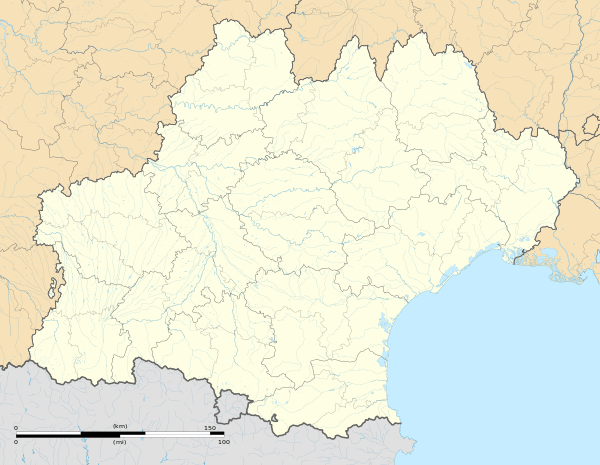Villeneuve-lès-Avignon
Villeneuve-lès-Avignon (French pronunciation: [vil'nœv lez‿avi'ɲɔ̃]; Provençal: Vilanòva d’Avinhon) is a commune in the Gard department in southern France. It can also be spelled Villeneuve-lez-Avignon.
Villeneuve-lès-Avignon | |
|---|---|
Fort Saint-André on Mont Andaon | |
.svg.png) Coat of arms | |
Location of Villeneuve-lès-Avignon 
| |
 Villeneuve-lès-Avignon  Villeneuve-lès-Avignon | |
| Coordinates: 43°58′02″N 4°47′48″E | |
| Country | France |
| Region | Occitanie |
| Department | Gard |
| Arrondissement | Nîmes |
| Canton | Villeneuve-lès-Avignon |
| Intercommunality | CA Grand Avignon |
| Government | |
| • Mayor (2020-2026) | Pascale Bories |
| Area 1 | 18.27 km2 (7.05 sq mi) |
| Population (2017-01-01)[1] | 11,698 |
| • Density | 640/km2 (1,700/sq mi) |
| Time zone | UTC+01:00 (CET) |
| • Summer (DST) | UTC+02:00 (CEST) |
| INSEE/Postal code | 30351 /30400 |
| Elevation | 10–181 m (33–594 ft) (avg. 25 m or 82 ft) |
| 1 French Land Register data, which excludes lakes, ponds, glaciers > 1 km2 (0.386 sq mi or 247 acres) and river estuaries. | |
History
In the 6th century the Benedictine abbey of St André was founded on Mount Andaon, and the village which grew up round it took its name.[2] The city itself was founded by Philippe le Bel and boasts a castle he built, Fort Saint-André.
The town was also the resort of the French cardinals during the sojourn of the popes at Avignon, in the 14th century.[2]
Geography
It is located by the Rhône River, opposite Avignon.
Population
| Year | Pop. | ±% |
|---|---|---|
| 1793 | 3,300 | — |
| 1800 | 3,297 | −0.1% |
| 1806 | 3,279 | −0.5% |
| 1821 | 3,232 | −1.4% |
| 1831 | 3,564 | +10.3% |
| 1836 | 3,633 | +1.9% |
| 1841 | 3,671 | +1.0% |
| 1846 | 3,723 | +1.4% |
| 1851 | 3,733 | +0.3% |
| 1856 | 3,252 | −12.9% |
| 1861 | 3,162 | −2.8% |
| 1866 | 3,067 | −3.0% |
| 1872 | 2,730 | −11.0% |
| 1876 | 2,910 | +6.6% |
| 1881 | 2,630 | −9.6% |
| 1886 | 2,644 | +0.5% |
| 1891 | 2,622 | −0.8% |
| 1896 | 2,735 | +4.3% |
| 1901 | 2,922 | +6.8% |
| 1906 | 2,890 | −1.1% |
| 1911 | 2,709 | −6.3% |
| 1921 | 2,561 | −5.5% |
| 1926 | 3,035 | +18.5% |
| 1931 | 3,635 | +19.8% |
| 1936 | 3,740 | +2.9% |
| 1946 | 4,399 | +17.6% |
| 1954 | 5,157 | +17.2% |
| 1962 | 6,422 | +24.5% |
| 1968 | 6,977 | +8.6% |
| 1975 | 8,540 | +22.4% |
| 1982 | 9,282 | +8.7% |
| 1990 | 10,730 | +15.6% |
| 1999 | 11,791 | +9.9% |
| 2008 | 12,756 | +8.2% |
| 2012 | 12,232 | −4.1% |
| 2017 | 11,698 | −4.4% |
Sights
- Fort Saint-André, on a hill outside the town
- Tour Philippe Le Bel, 14th century
- The church of Notre Dame, dating from the 14th century, contains a rich marble altar and significant pictures.[2]
- Carthusian monastery Notre-Dame-du-val-de-Bénédiction, founded in 1356 by Pope Innocent VI[2]
International relations
Gallery
- Tour Philippe Le Bel

- Chartreuse du Val de Bénédiction
- Collapsed apse of church, Chartreuse du Val de Bénédiction
- Cloister of Saint John, Chartreuse du Val de Bénédiction
- Chapel of the frescos, Chartreuse du Val de Bénédiction
 Tomb of Pope Innocent VI, Chartreuse du Val de Bénédiction
Tomb of Pope Innocent VI, Chartreuse du Val de Bénédiction
gollark: They are NEVER too long.
gollark: ++delete <@341618941317349376>
gollark: uglify-js?
gollark: I've put it on github: https://github.com/osmarks/mtmanager
gollark: ···
See also
- Communes of the Gard department
- Pont d'Avignon
References
- "Populations légales 2017". INSEE. Retrieved 6 January 2020.
-

Further reading
- Fabrié, Marie-Luce (2000). "La collégiale Notre-Dame de Villeneuve-lez-Avignon". Congrès archéologique de France - Monuments du Gard, 157e session 1999 (in French). Paris: Société française d'archéologie. pp. 455–465.
- Labande, M. L.-H. (1910). "Villeneuve-lez-Avignon". Congrès archéologique de France, 76e session, 1909, Avignon. Volume 1 Guide du Congrès (in French). Paris: Picard. pp. 129–130.
- Labande, M. L.-H. (1910). "La Collégiale de Notre-Dame". Congrès archéologique de France, 76e session, 1909, Avignon. Volume 1 Guide du Congrès (in French). Paris: Picard. pp. 141–144.
- Labande, M. L.-H. (1910). "La Chartreuse". Congrès archéologique de France, 76e session, 1909, Avignon. Volume 1 Guide du Congrès (in French). Paris: Picard. pp. 144–158.
This article is issued from Wikipedia. The text is licensed under Creative Commons - Attribution - Sharealike. Additional terms may apply for the media files.